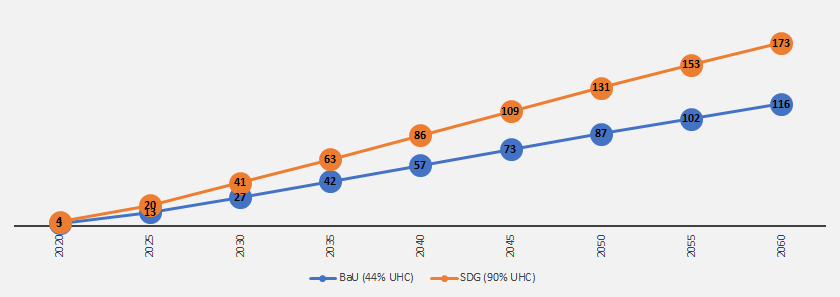 Nursing students doing practice at the Mbale Regional Referral hospital. Investments in health and education are critical to build Uganda’s human capital and to realize the potential of the country’s young population. Photo: Morgan Mbabazi/World Bank
Nursing students doing practice at the Mbale Regional Referral hospital. Investments in health and education are critical to build Uganda’s human capital and to realize the potential of the country’s young population. Photo: Morgan Mbabazi/World Bank
The COVID-19 (coronavirus) pandemic and associated restrictions has had huge impacts on the education and health sectors In Uganda. Schools were closed for seven months and access to online learning was limited, exacerbating pre-existing inequalities among students (Figure 1). According to mathematical models, mobility restrictions and precautions taken to avoid potential exposure to the virus have high potential to compromise access and uptake of routine basic health services, such as children’s vaccinations and births in a facility (Figure 2). These impacts are particularly relevant given the swelling young population and the growing demands on basic education and health services. As such, recovering from the COVID-19 shock requires even greater attention to and investment in the fundamental skills and health needed for Uganda’s young population to realize their potential.
Figure 1. Share of households with at least one child (3-18) attending school before school closure and engaged in any education or learning activities after school closures, (%)

Figure 2. Modelled potential impact of COVID-19 on access and uptake of routine basic health services
| Current coverage | Coverage is services disrupted | Fewer people receiving services due to disruptions | |
| Oral antibiotics for pneumonia in children | 71 | 36 | 1,358,400 |
| Diphtheria, pertussis and tetanus vaccination for children | 93 | 45 | 1,862,700 |
| Facility-based deliveries | 73 | 37 | 301,300 |
| Contraceptive prevalence rate | 44 | 26 | 941,800 |
Source: Global Financing Facility, 2020
The population of Uganda is currently estimated at 46 million and is most likely going to rise to around 104 million by 2060. Close to 70% of that population will be of working age. This presents both an enormous opportunity and a challenge since the soon-to-be working age population needs to have the skills and health necessary to be fully productive and access better job opportunities. However, the current status quo in terms of quality and access to education and health services is limiting the human capital accumulation of young Ugandans, constraining their income-generating ability and curbing their future productivity. Currently, a child born in Uganda will only be 38% as productive when she grows up as she could be if she enjoyed complete education and full health according to the Human Capital Index —one of the lowest levels in the world. If education and health investments per capita do not keep up with population growth, the situation will become even more dire. Expanding access and improving the quality of basic education and health services will be crucial if Uganda wants to move to a development path that ensures higher shared prosperity.
Our latest Uganda Economic Update, Investing in Uganda’s Youth, informs policymakers, stakeholders and the broad public about Uganda’s demographic trends and the implications for the education and health sectors. In particular, the analysis shows the sizeable effort that will be needed to improve the quality of services and get Uganda on track to meet the sustainable development goals (SDGs) for education and health, such as universal secondary school enrolment and near universal health coverage. Taking stock of the large resource requirements – more than 10,000 additional secondary school teachers per year for the next five years, a doubling of the number of secondary school classrooms over the next five years, and 20 additional general hospitals between now and 2025, among others (Figures 3 and 4) – is important for the government and other stakeholders to consider as they formulate medium term investment plans and policy actions to provide Uganda’s youth with the skills and health they need to reach their potential.
Figure 3. Public teachers, (thousands)

Figure 4. Additional (general) hospitals required

Note: ‘BaU’ refers to the ‘Business as Usual’ scenario, under which current access rates and quality are maintained. ‘SDG’ refers to the ‘Sustainable Development Goals’ scenario, under which access rates are vastly increased (near universal) and quality is also improved.
While the fiscal effort necessary to achieve these goals is considerable – doubling the average annual education and health budgets in the 2020-25 period (Figures 5 and 6)– not doing so or just maintaining the current access rates and quality of services will be insufficient for Uganda to really achieve the benefits of the demographic dividend, where more young people will have quality jobs and contribute to economic growth. These projections highlight the importance of increasing the efficiency of education and health sector spending, while also bringing in more private investment. Doing so is essential for Uganda to capture this unique moment in its demographic transition, stimulate faster recovery from the COVID-19 shock, and therefore put education and health at the forefront of the agenda for the country’s youth.

Note: ‘BaU’ refers to the ‘Business as Usual’ scenario, under which current access rates and quality are maintained. ‘SDG’ refers to the ‘Sustainable Development Goals’ scenario, under which access rates are vastly increased (near universal) and quality is also improved.
*GGHE refers to the General Government Health Expenditure
^GGBH refers to the General Government Budget for Health

Note: ‘BaU’ refers to the ‘Business as Usual’ scenario, under which current access rates and quality are maintained. ‘SDG’ refers to the ‘Sustainable Development Goals’ scenario, under which access rates are vastly increased (near universal) and quality is also improved.
*GGHE refers to the General Government Health Expenditure
^GGBH refers to the General Government Budget for Health


Join the Conversation